NIT6130 Literature Review: Analyzing Smart Watches in Healthcare
VerifiedAdded on 2024/05/29
|22
|3713
|321
Literature Review
AI Summary
This literature review examines the use of smart watches in healthcare, analyzing research from various journals to understand the benefits and challenges of incorporating wearable technology into patient care. The review includes a broad scan of relevant literature, followed by a focused review of selected papers that delve into the application of smart watches for monitoring patient health. Key areas explored include the use of storyboards to gather patient feedback, the framework and methods for implementing smart watch-based healthcare solutions, and the potential for wearable devices to continuously monitor patient progress and improve the quality of care services. The review also addresses the increasing prevalence of heart-related diseases and how smart watches can provide comprehensive monitoring solutions, considering factors such as user-friendliness, data accuracy, and reliability. The ultimate goal is to provide a thorough analysis of the current state of research on smart watches in healthcare and identify areas for future investigation.
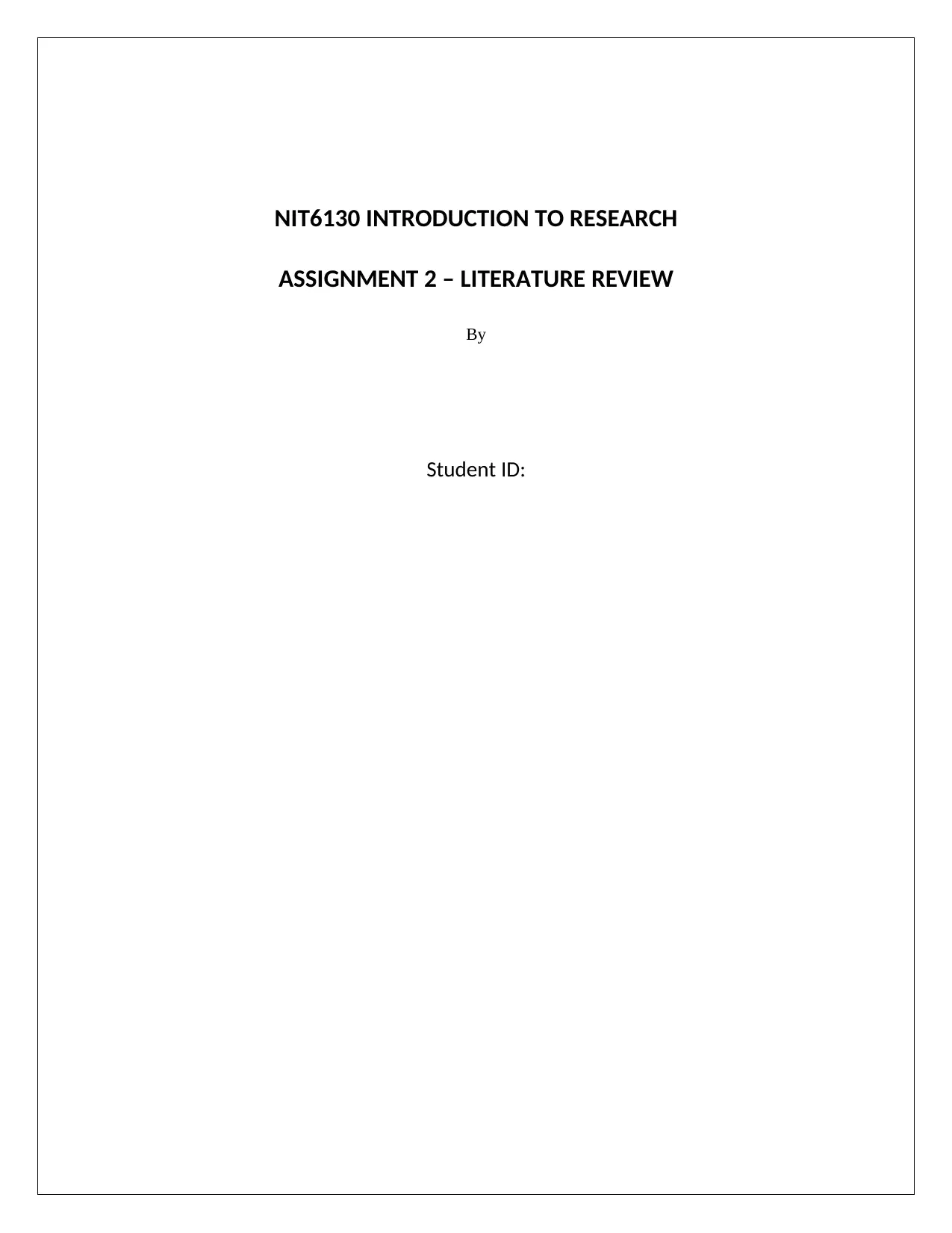
NIT6130 INTRODUCTION TO RESEARCH
ASSIGNMENT 2 – LITERATURE REVIEW
By
Student ID:
ASSIGNMENT 2 – LITERATURE REVIEW
By
Student ID:
Paraphrase This Document
Need a fresh take? Get an instant paraphrase of this document with our AI Paraphraser
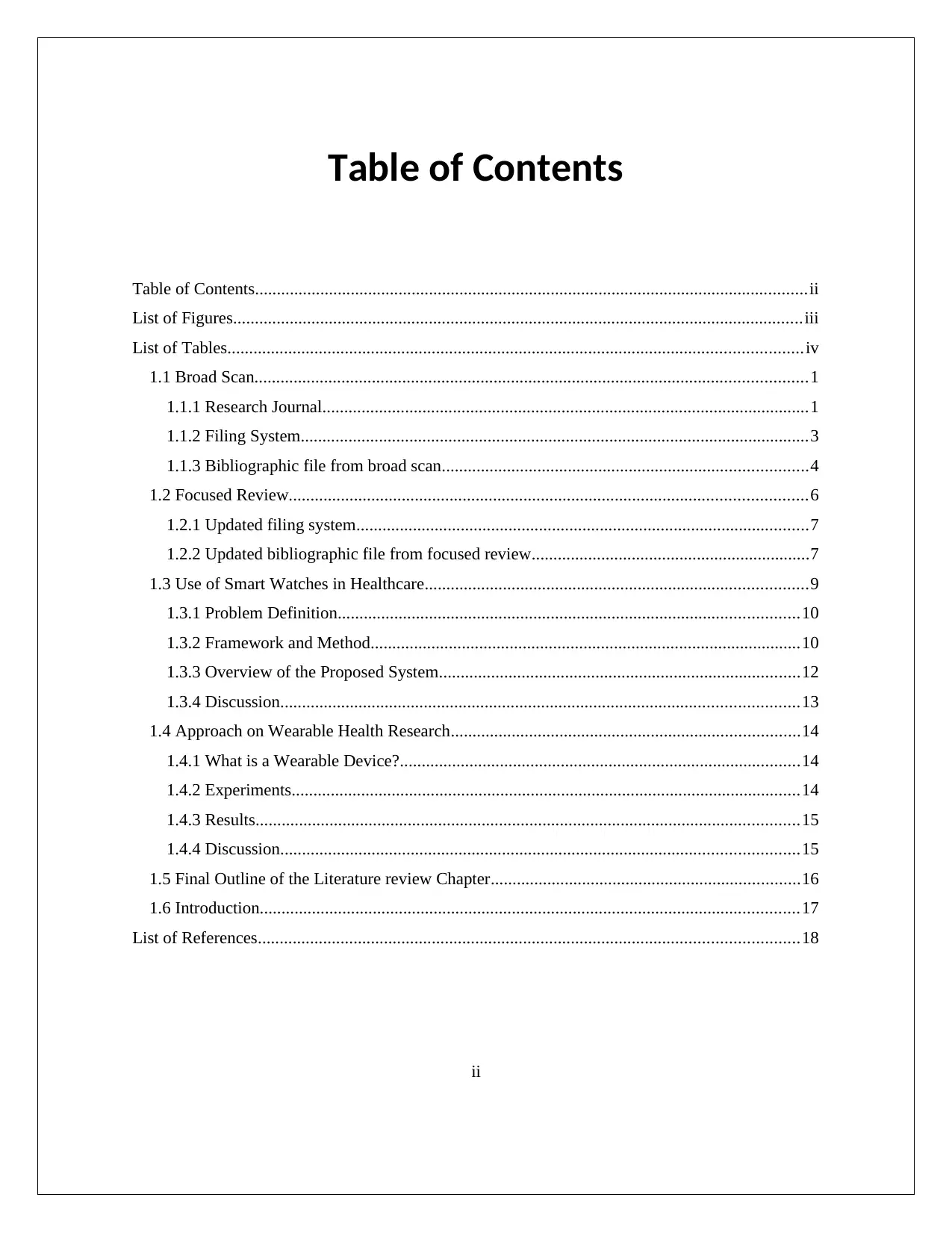
Table of Contents
Table of Contents...............................................................................................................................ii
List of Figures...................................................................................................................................iii
List of Tables....................................................................................................................................iv
1.1 Broad Scan...............................................................................................................................1
1.1.1 Research Journal................................................................................................................1
1.1.2 Filing System.....................................................................................................................3
1.1.3 Bibliographic file from broad scan....................................................................................4
1.2 Focused Review.......................................................................................................................6
1.2.1 Updated filing system........................................................................................................7
1.2.2 Updated bibliographic file from focused review................................................................7
1.3 Use of Smart Watches in Healthcare........................................................................................9
1.3.1 Problem Definition..........................................................................................................10
1.3.2 Framework and Method...................................................................................................10
1.3.3 Overview of the Proposed System...................................................................................12
1.3.4 Discussion.......................................................................................................................13
1.4 Approach on Wearable Health Research................................................................................14
1.4.1 What is a Wearable Device?............................................................................................14
1.4.2 Experiments.....................................................................................................................14
1.4.3 Results.............................................................................................................................15
1.4.4 Discussion.......................................................................................................................15
1.5 Final Outline of the Literature review Chapter.......................................................................16
1.6 Introduction............................................................................................................................17
List of References............................................................................................................................18
ii
Table of Contents...............................................................................................................................ii
List of Figures...................................................................................................................................iii
List of Tables....................................................................................................................................iv
1.1 Broad Scan...............................................................................................................................1
1.1.1 Research Journal................................................................................................................1
1.1.2 Filing System.....................................................................................................................3
1.1.3 Bibliographic file from broad scan....................................................................................4
1.2 Focused Review.......................................................................................................................6
1.2.1 Updated filing system........................................................................................................7
1.2.2 Updated bibliographic file from focused review................................................................7
1.3 Use of Smart Watches in Healthcare........................................................................................9
1.3.1 Problem Definition..........................................................................................................10
1.3.2 Framework and Method...................................................................................................10
1.3.3 Overview of the Proposed System...................................................................................12
1.3.4 Discussion.......................................................................................................................13
1.4 Approach on Wearable Health Research................................................................................14
1.4.1 What is a Wearable Device?............................................................................................14
1.4.2 Experiments.....................................................................................................................14
1.4.3 Results.............................................................................................................................15
1.4.4 Discussion.......................................................................................................................15
1.5 Final Outline of the Literature review Chapter.......................................................................16
1.6 Introduction............................................................................................................................17
List of References............................................................................................................................18
ii
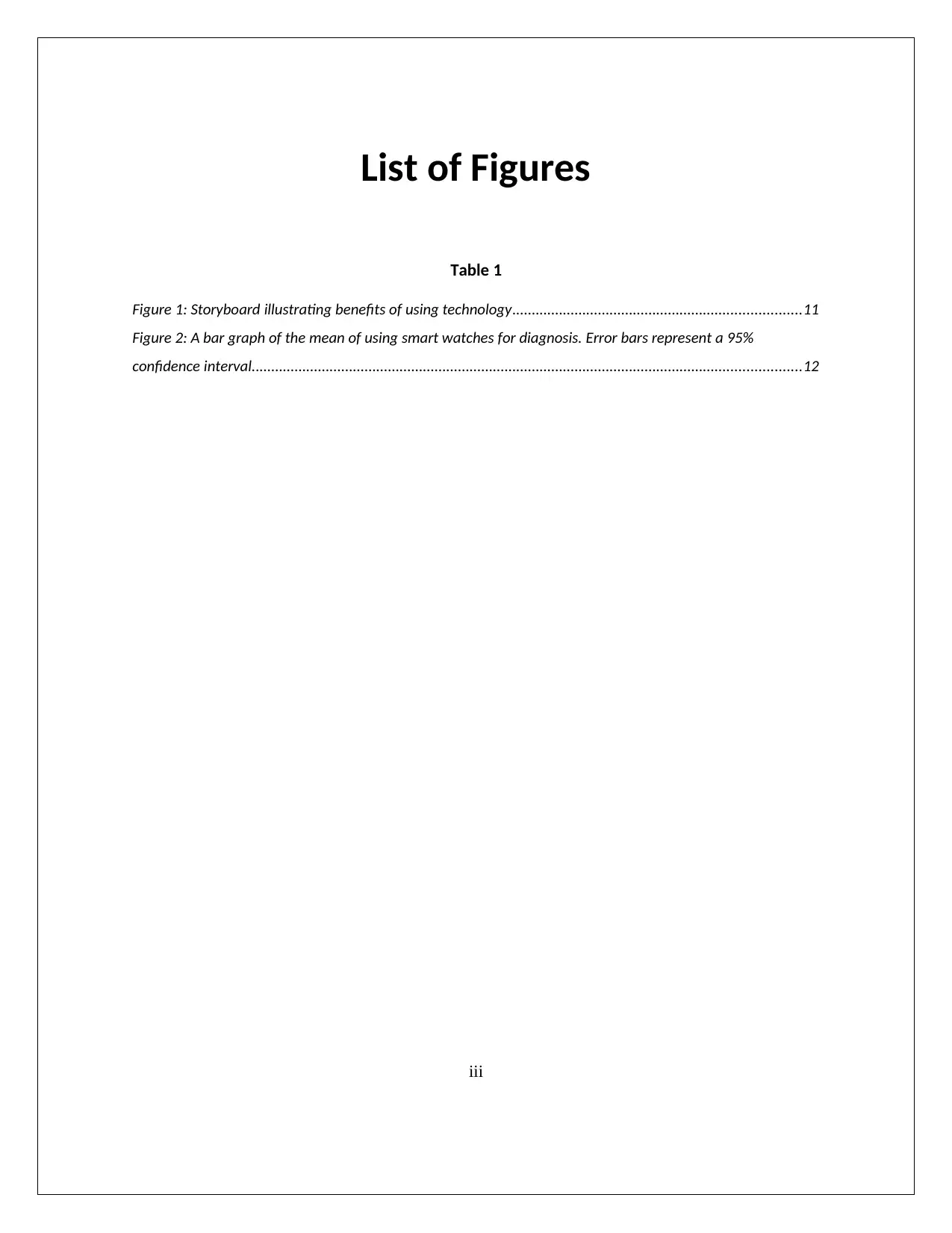
List of Figures
Table 1
Figure 1: Storyboard illustrating benefits of using technology..........................................................................11
Figure 2: A bar graph of the mean of using smart watches for diagnosis. Error bars represent a 95%
confidence interval.............................................................................................................................................12
iii
Table 1
Figure 1: Storyboard illustrating benefits of using technology..........................................................................11
Figure 2: A bar graph of the mean of using smart watches for diagnosis. Error bars represent a 95%
confidence interval.............................................................................................................................................12
iii
⊘ This is a preview!⊘
Do you want full access?
Subscribe today to unlock all pages.

Trusted by 1+ million students worldwide
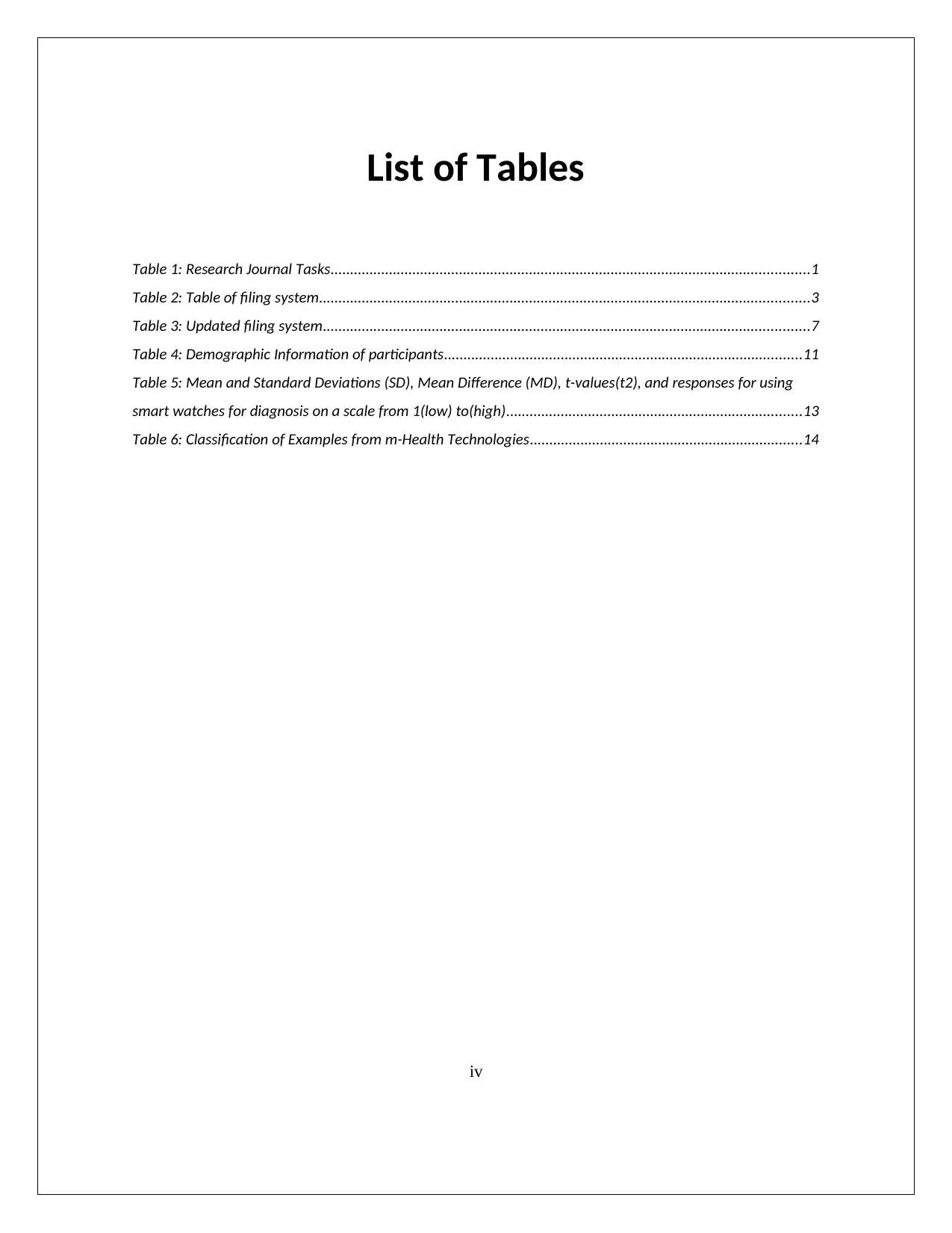
List of Tables
Table 1: Research Journal Tasks...........................................................................................................................1
Table 2: Table of filing system..............................................................................................................................3
Table 3: Updated filing system.............................................................................................................................7
Table 4: Demographic Information of participants............................................................................................11
Table 5: Mean and Standard Deviations (SD), Mean Difference (MD), t-values(t2), and responses for using
smart watches for diagnosis on a scale from 1(low) to(high)............................................................................13
Table 6: Classification of Examples from m-Health Technologies......................................................................14
iv
Table 1: Research Journal Tasks...........................................................................................................................1
Table 2: Table of filing system..............................................................................................................................3
Table 3: Updated filing system.............................................................................................................................7
Table 4: Demographic Information of participants............................................................................................11
Table 5: Mean and Standard Deviations (SD), Mean Difference (MD), t-values(t2), and responses for using
smart watches for diagnosis on a scale from 1(low) to(high)............................................................................13
Table 6: Classification of Examples from m-Health Technologies......................................................................14
iv
Paraphrase This Document
Need a fresh take? Get an instant paraphrase of this document with our AI Paraphraser
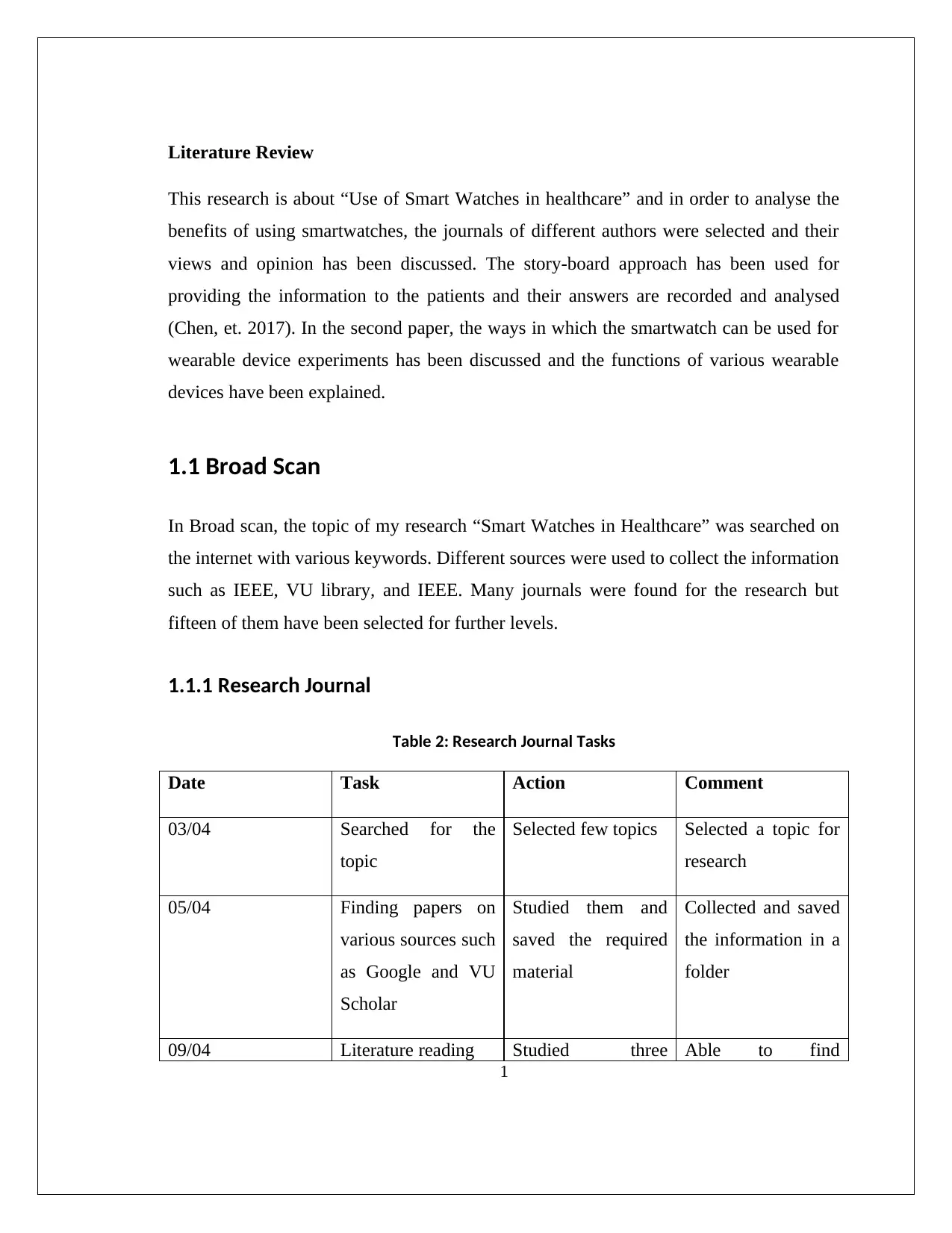
Literature Review
This research is about “Use of Smart Watches in healthcare” and in order to analyse the
benefits of using smartwatches, the journals of different authors were selected and their
views and opinion has been discussed. The story-board approach has been used for
providing the information to the patients and their answers are recorded and analysed
(Chen, et. 2017). In the second paper, the ways in which the smartwatch can be used for
wearable device experiments has been discussed and the functions of various wearable
devices have been explained.
1.1 Broad Scan
In Broad scan, the topic of my research “Smart Watches in Healthcare” was searched on
the internet with various keywords. Different sources were used to collect the information
such as IEEE, VU library, and IEEE. Many journals were found for the research but
fifteen of them have been selected for further levels.
1.1.1 Research Journal
Table 2: Research Journal Tasks
Date Task Action Comment
03/04 Searched for the
topic
Selected few topics Selected a topic for
research
05/04 Finding papers on
various sources such
as Google and VU
Scholar
Studied them and
saved the required
material
Collected and saved
the information in a
folder
09/04 Literature reading Studied three Able to find
1
This research is about “Use of Smart Watches in healthcare” and in order to analyse the
benefits of using smartwatches, the journals of different authors were selected and their
views and opinion has been discussed. The story-board approach has been used for
providing the information to the patients and their answers are recorded and analysed
(Chen, et. 2017). In the second paper, the ways in which the smartwatch can be used for
wearable device experiments has been discussed and the functions of various wearable
devices have been explained.
1.1 Broad Scan
In Broad scan, the topic of my research “Smart Watches in Healthcare” was searched on
the internet with various keywords. Different sources were used to collect the information
such as IEEE, VU library, and IEEE. Many journals were found for the research but
fifteen of them have been selected for further levels.
1.1.1 Research Journal
Table 2: Research Journal Tasks
Date Task Action Comment
03/04 Searched for the
topic
Selected few topics Selected a topic for
research
05/04 Finding papers on
various sources such
as Google and VU
Scholar
Studied them and
saved the required
material
Collected and saved
the information in a
folder
09/04 Literature reading Studied three Able to find
1
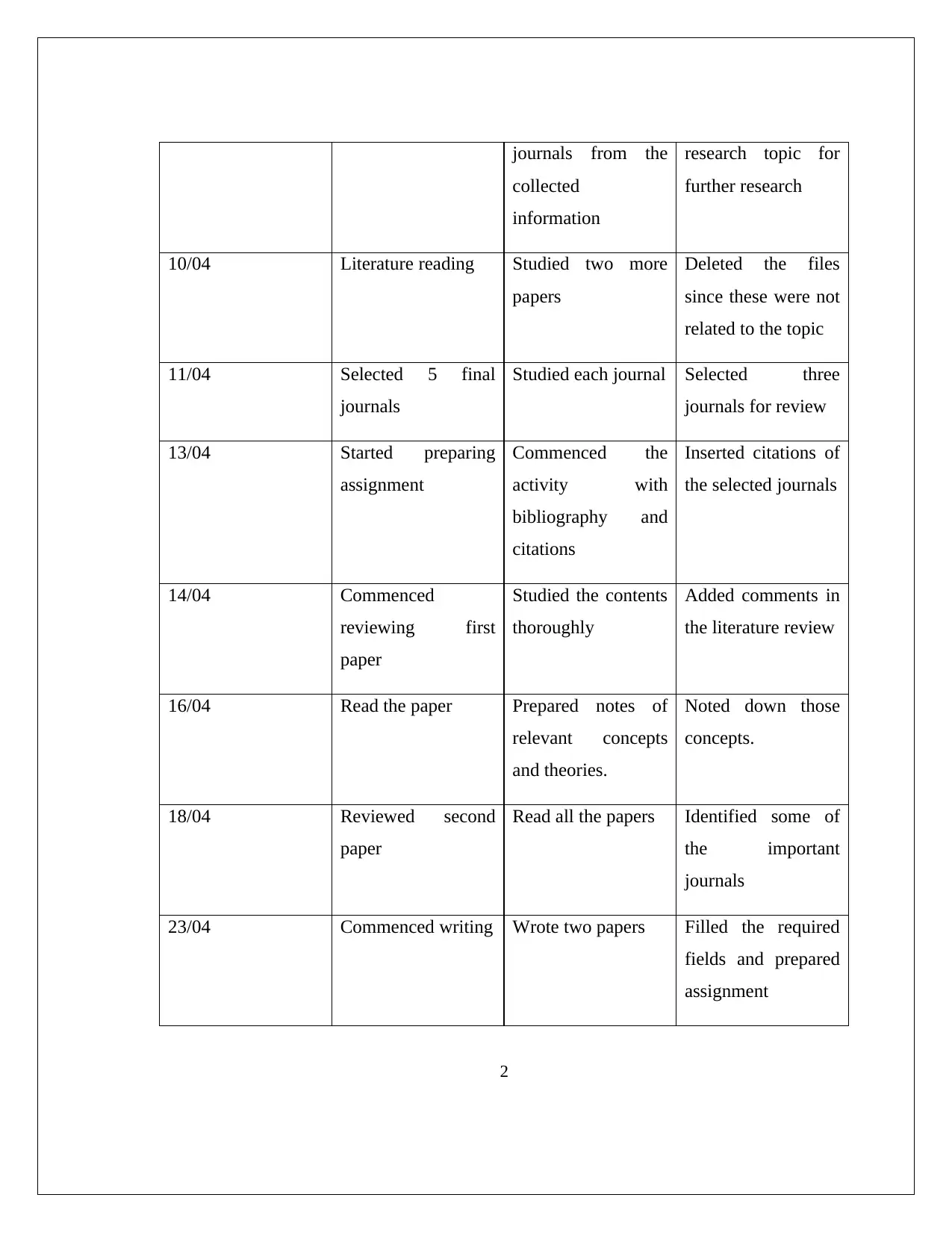
journals from the
collected
information
research topic for
further research
10/04 Literature reading Studied two more
papers
Deleted the files
since these were not
related to the topic
11/04 Selected 5 final
journals
Studied each journal Selected three
journals for review
13/04 Started preparing
assignment
Commenced the
activity with
bibliography and
citations
Inserted citations of
the selected journals
14/04 Commenced
reviewing first
paper
Studied the contents
thoroughly
Added comments in
the literature review
16/04 Read the paper Prepared notes of
relevant concepts
and theories.
Noted down those
concepts.
18/04 Reviewed second
paper
Read all the papers Identified some of
the important
journals
23/04 Commenced writing Wrote two papers Filled the required
fields and prepared
assignment
2
collected
information
research topic for
further research
10/04 Literature reading Studied two more
papers
Deleted the files
since these were not
related to the topic
11/04 Selected 5 final
journals
Studied each journal Selected three
journals for review
13/04 Started preparing
assignment
Commenced the
activity with
bibliography and
citations
Inserted citations of
the selected journals
14/04 Commenced
reviewing first
paper
Studied the contents
thoroughly
Added comments in
the literature review
16/04 Read the paper Prepared notes of
relevant concepts
and theories.
Noted down those
concepts.
18/04 Reviewed second
paper
Read all the papers Identified some of
the important
journals
23/04 Commenced writing Wrote two papers Filled the required
fields and prepared
assignment
2
⊘ This is a preview!⊘
Do you want full access?
Subscribe today to unlock all pages.

Trusted by 1+ million students worldwide
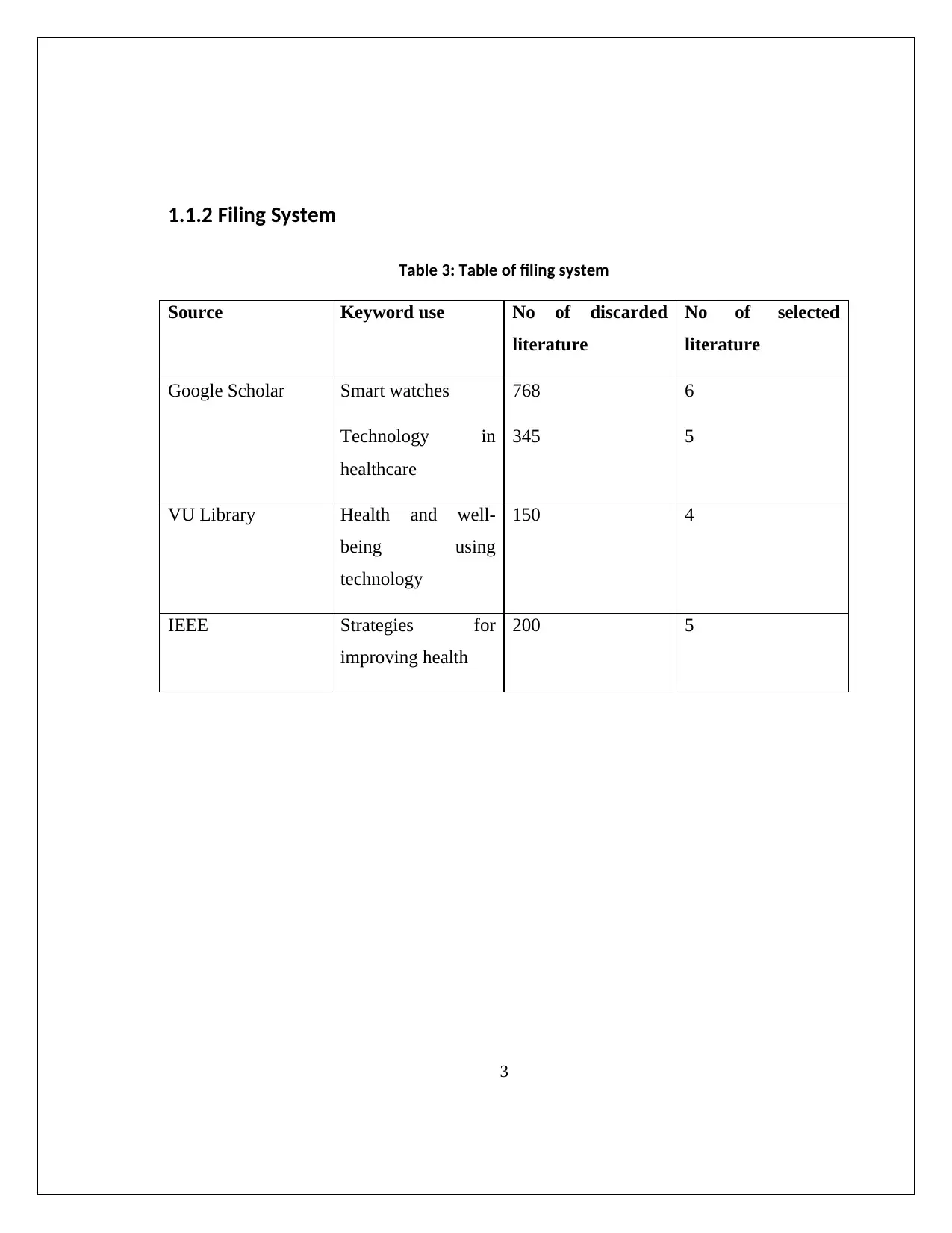
1.1.2 Filing System
Table 3: Table of filing system
Source Keyword use No of discarded
literature
No of selected
literature
Google Scholar Smart watches
Technology in
healthcare
768
345
6
5
VU Library Health and well-
being using
technology
150 4
IEEE Strategies for
improving health
200 5
3
Table 3: Table of filing system
Source Keyword use No of discarded
literature
No of selected
literature
Google Scholar Smart watches
Technology in
healthcare
768
345
6
5
VU Library Health and well-
being using
technology
150 4
IEEE Strategies for
improving health
200 5
3
Paraphrase This Document
Need a fresh take? Get an instant paraphrase of this document with our AI Paraphraser
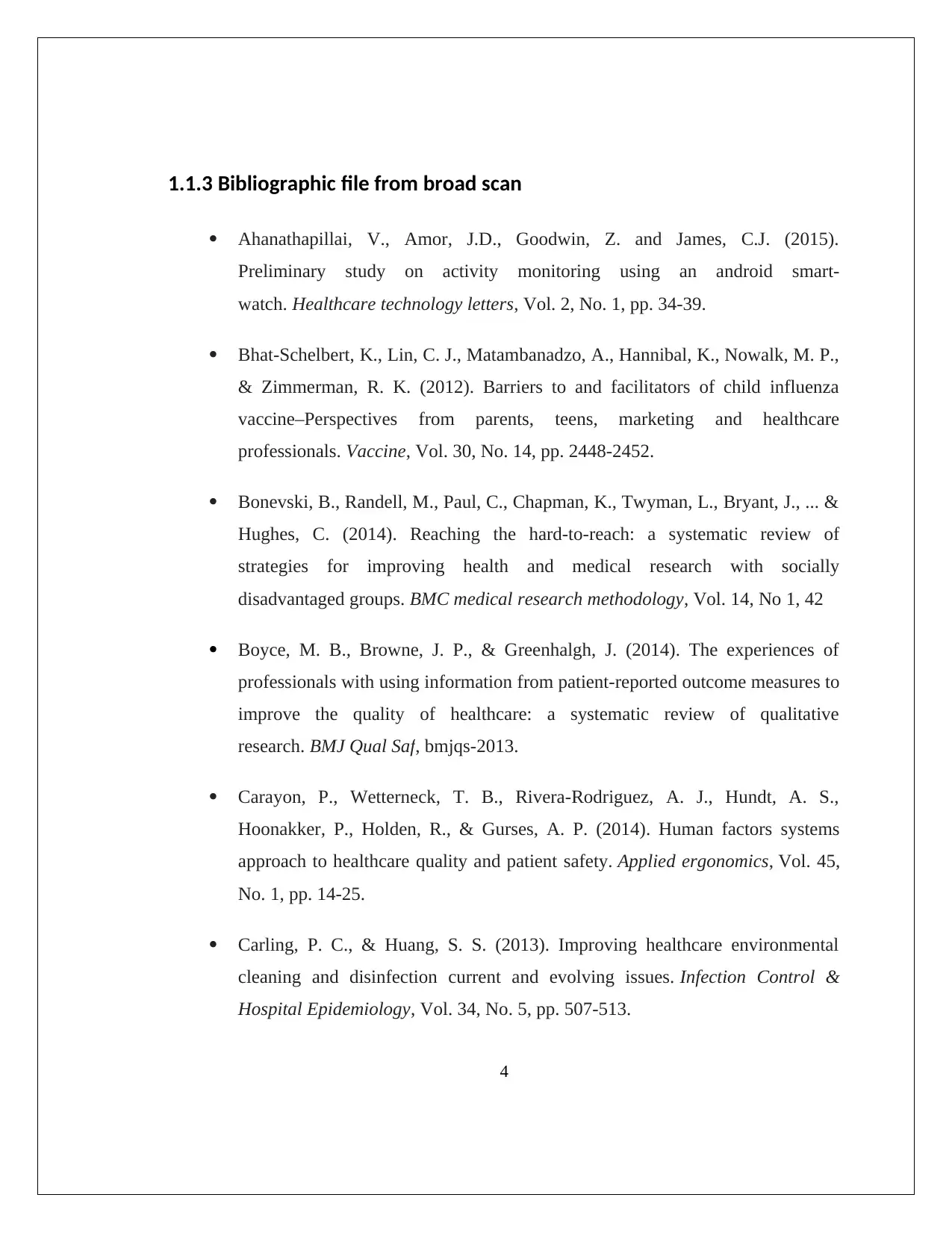
1.1.3 Bibliographic file from broad scan
Ahanathapillai, V., Amor, J.D., Goodwin, Z. and James, C.J. (2015).
Preliminary study on activity monitoring using an android smart-
watch. Healthcare technology letters, Vol. 2, No. 1, pp. 34-39.
Bhat-Schelbert, K., Lin, C. J., Matambanadzo, A., Hannibal, K., Nowalk, M. P.,
& Zimmerman, R. K. (2012). Barriers to and facilitators of child influenza
vaccine–Perspectives from parents, teens, marketing and healthcare
professionals. Vaccine, Vol. 30, No. 14, pp. 2448-2452.
Bonevski, B., Randell, M., Paul, C., Chapman, K., Twyman, L., Bryant, J., ... &
Hughes, C. (2014). Reaching the hard-to-reach: a systematic review of
strategies for improving health and medical research with socially
disadvantaged groups. BMC medical research methodology, Vol. 14, No 1, 42
Boyce, M. B., Browne, J. P., & Greenhalgh, J. (2014). The experiences of
professionals with using information from patient-reported outcome measures to
improve the quality of healthcare: a systematic review of qualitative
research. BMJ Qual Saf, bmjqs-2013.
Carayon, P., Wetterneck, T. B., Rivera-Rodriguez, A. J., Hundt, A. S.,
Hoonakker, P., Holden, R., & Gurses, A. P. (2014). Human factors systems
approach to healthcare quality and patient safety. Applied ergonomics, Vol. 45,
No. 1, pp. 14-25.
Carling, P. C., & Huang, S. S. (2013). Improving healthcare environmental
cleaning and disinfection current and evolving issues. Infection Control &
Hospital Epidemiology, Vol. 34, No. 5, pp. 507-513.
4
Ahanathapillai, V., Amor, J.D., Goodwin, Z. and James, C.J. (2015).
Preliminary study on activity monitoring using an android smart-
watch. Healthcare technology letters, Vol. 2, No. 1, pp. 34-39.
Bhat-Schelbert, K., Lin, C. J., Matambanadzo, A., Hannibal, K., Nowalk, M. P.,
& Zimmerman, R. K. (2012). Barriers to and facilitators of child influenza
vaccine–Perspectives from parents, teens, marketing and healthcare
professionals. Vaccine, Vol. 30, No. 14, pp. 2448-2452.
Bonevski, B., Randell, M., Paul, C., Chapman, K., Twyman, L., Bryant, J., ... &
Hughes, C. (2014). Reaching the hard-to-reach: a systematic review of
strategies for improving health and medical research with socially
disadvantaged groups. BMC medical research methodology, Vol. 14, No 1, 42
Boyce, M. B., Browne, J. P., & Greenhalgh, J. (2014). The experiences of
professionals with using information from patient-reported outcome measures to
improve the quality of healthcare: a systematic review of qualitative
research. BMJ Qual Saf, bmjqs-2013.
Carayon, P., Wetterneck, T. B., Rivera-Rodriguez, A. J., Hundt, A. S.,
Hoonakker, P., Holden, R., & Gurses, A. P. (2014). Human factors systems
approach to healthcare quality and patient safety. Applied ergonomics, Vol. 45,
No. 1, pp. 14-25.
Carling, P. C., & Huang, S. S. (2013). Improving healthcare environmental
cleaning and disinfection current and evolving issues. Infection Control &
Hospital Epidemiology, Vol. 34, No. 5, pp. 507-513.
4

Chen, M., Ma, Y., Li, Y., Wu, D., Zhang, Y. and Youn, C.H. (2017). Wearable
2.0: Enabling human-cloud integration in next generation healthcare
systems. IEEE Communications Magazine, Vol. 55, No1), pp. 54-61.
Devaraj, S., Ow, T. T., & Kohli, R. (2013). Examining the impact of
information technology and patient flow on healthcare performance: A Theory
of Swift and Even Flow (TSEF) perspective. Journal of Operations
Management, Vol. 31, No. 4, pp. 181-192.
DiMatteo, M. R., Haskard-Zolnierek, K. B., & Martin, L. R. (2012). Improving
patient adherence: a three-factor model to guide practice. Health Psychology
Review, Vol. 6, No. 1, pp. 74-91.
Kellermann, A. L., & Jones, S. S. (2013). What it will take to achieve the as-
yet-unfulfilled promises of health information technology. Health affairs, Vol.
32, No. 1, pp. 63-68.
Kim, K.J. and Shin, D.H. (2015). An acceptance model for smart watches:
Implications for the adoption of future wearable technology. Internet Research,
Vol. 25, No. 4, pp. 527-541.
Nanji, K. C., Ferris, T. G., Torchiana, D. F., & Meyer, G. S. (2013).
Overarching goals: a strategy for improving healthcare quality and safety?. BMJ
Qual Saf, Vol. 22, No. 3, pp. 187-193.
Porzi, L., Messelodi, S., Modena, C.M. and Ricci, E. (2013). A smart watch-
based gesture recognition system for assisting people with visual impairments.
In Proceedings of the 3rd ACM international workshop on Interactive
multimedia on mobile & portable devices (pp. 19-24). ACM.
5
2.0: Enabling human-cloud integration in next generation healthcare
systems. IEEE Communications Magazine, Vol. 55, No1), pp. 54-61.
Devaraj, S., Ow, T. T., & Kohli, R. (2013). Examining the impact of
information technology and patient flow on healthcare performance: A Theory
of Swift and Even Flow (TSEF) perspective. Journal of Operations
Management, Vol. 31, No. 4, pp. 181-192.
DiMatteo, M. R., Haskard-Zolnierek, K. B., & Martin, L. R. (2012). Improving
patient adherence: a three-factor model to guide practice. Health Psychology
Review, Vol. 6, No. 1, pp. 74-91.
Kellermann, A. L., & Jones, S. S. (2013). What it will take to achieve the as-
yet-unfulfilled promises of health information technology. Health affairs, Vol.
32, No. 1, pp. 63-68.
Kim, K.J. and Shin, D.H. (2015). An acceptance model for smart watches:
Implications for the adoption of future wearable technology. Internet Research,
Vol. 25, No. 4, pp. 527-541.
Nanji, K. C., Ferris, T. G., Torchiana, D. F., & Meyer, G. S. (2013).
Overarching goals: a strategy for improving healthcare quality and safety?. BMJ
Qual Saf, Vol. 22, No. 3, pp. 187-193.
Porzi, L., Messelodi, S., Modena, C.M. and Ricci, E. (2013). A smart watch-
based gesture recognition system for assisting people with visual impairments.
In Proceedings of the 3rd ACM international workshop on Interactive
multimedia on mobile & portable devices (pp. 19-24). ACM.
5
⊘ This is a preview!⊘
Do you want full access?
Subscribe today to unlock all pages.

Trusted by 1+ million students worldwide
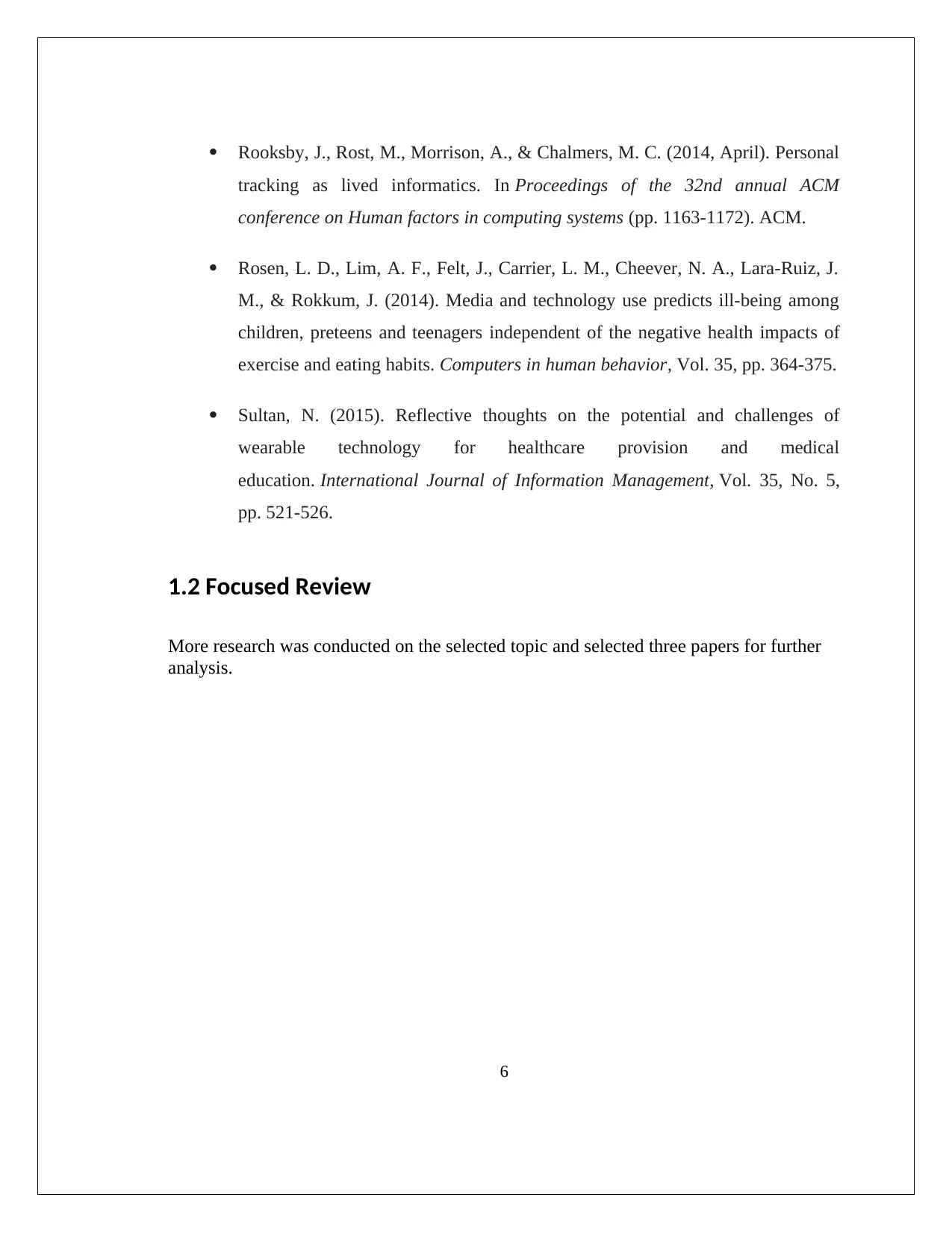
Rooksby, J., Rost, M., Morrison, A., & Chalmers, M. C. (2014, April). Personal
tracking as lived informatics. In Proceedings of the 32nd annual ACM
conference on Human factors in computing systems (pp. 1163-1172). ACM.
Rosen, L. D., Lim, A. F., Felt, J., Carrier, L. M., Cheever, N. A., Lara-Ruiz, J.
M., & Rokkum, J. (2014). Media and technology use predicts ill-being among
children, preteens and teenagers independent of the negative health impacts of
exercise and eating habits. Computers in human behavior, Vol. 35, pp. 364-375.
Sultan, N. (2015). Reflective thoughts on the potential and challenges of
wearable technology for healthcare provision and medical
education. International Journal of Information Management, Vol. 35, No. 5,
pp. 521-526.
1.2 Focused Review
More research was conducted on the selected topic and selected three papers for further
analysis.
6
tracking as lived informatics. In Proceedings of the 32nd annual ACM
conference on Human factors in computing systems (pp. 1163-1172). ACM.
Rosen, L. D., Lim, A. F., Felt, J., Carrier, L. M., Cheever, N. A., Lara-Ruiz, J.
M., & Rokkum, J. (2014). Media and technology use predicts ill-being among
children, preteens and teenagers independent of the negative health impacts of
exercise and eating habits. Computers in human behavior, Vol. 35, pp. 364-375.
Sultan, N. (2015). Reflective thoughts on the potential and challenges of
wearable technology for healthcare provision and medical
education. International Journal of Information Management, Vol. 35, No. 5,
pp. 521-526.
1.2 Focused Review
More research was conducted on the selected topic and selected three papers for further
analysis.
6
Paraphrase This Document
Need a fresh take? Get an instant paraphrase of this document with our AI Paraphraser
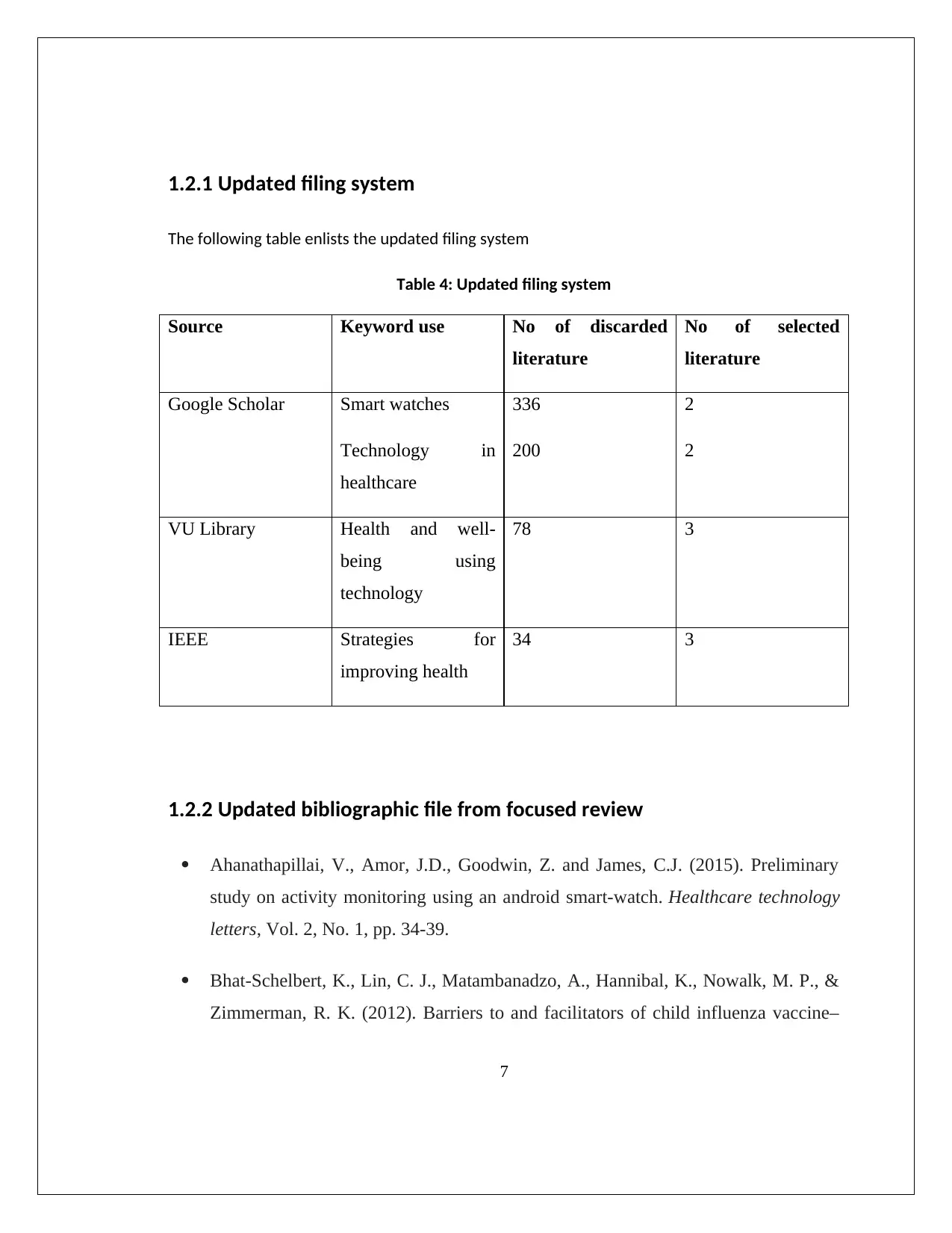
1.2.1 Updated filing system
The following table enlists the updated filing system
Table 4: Updated filing system
Source Keyword use No of discarded
literature
No of selected
literature
Google Scholar Smart watches
Technology in
healthcare
336
200
2
2
VU Library Health and well-
being using
technology
78 3
IEEE Strategies for
improving health
34 3
1.2.2 Updated bibliographic file from focused review
Ahanathapillai, V., Amor, J.D., Goodwin, Z. and James, C.J. (2015). Preliminary
study on activity monitoring using an android smart-watch. Healthcare technology
letters, Vol. 2, No. 1, pp. 34-39.
Bhat-Schelbert, K., Lin, C. J., Matambanadzo, A., Hannibal, K., Nowalk, M. P., &
Zimmerman, R. K. (2012). Barriers to and facilitators of child influenza vaccine–
7
The following table enlists the updated filing system
Table 4: Updated filing system
Source Keyword use No of discarded
literature
No of selected
literature
Google Scholar Smart watches
Technology in
healthcare
336
200
2
2
VU Library Health and well-
being using
technology
78 3
IEEE Strategies for
improving health
34 3
1.2.2 Updated bibliographic file from focused review
Ahanathapillai, V., Amor, J.D., Goodwin, Z. and James, C.J. (2015). Preliminary
study on activity monitoring using an android smart-watch. Healthcare technology
letters, Vol. 2, No. 1, pp. 34-39.
Bhat-Schelbert, K., Lin, C. J., Matambanadzo, A., Hannibal, K., Nowalk, M. P., &
Zimmerman, R. K. (2012). Barriers to and facilitators of child influenza vaccine–
7
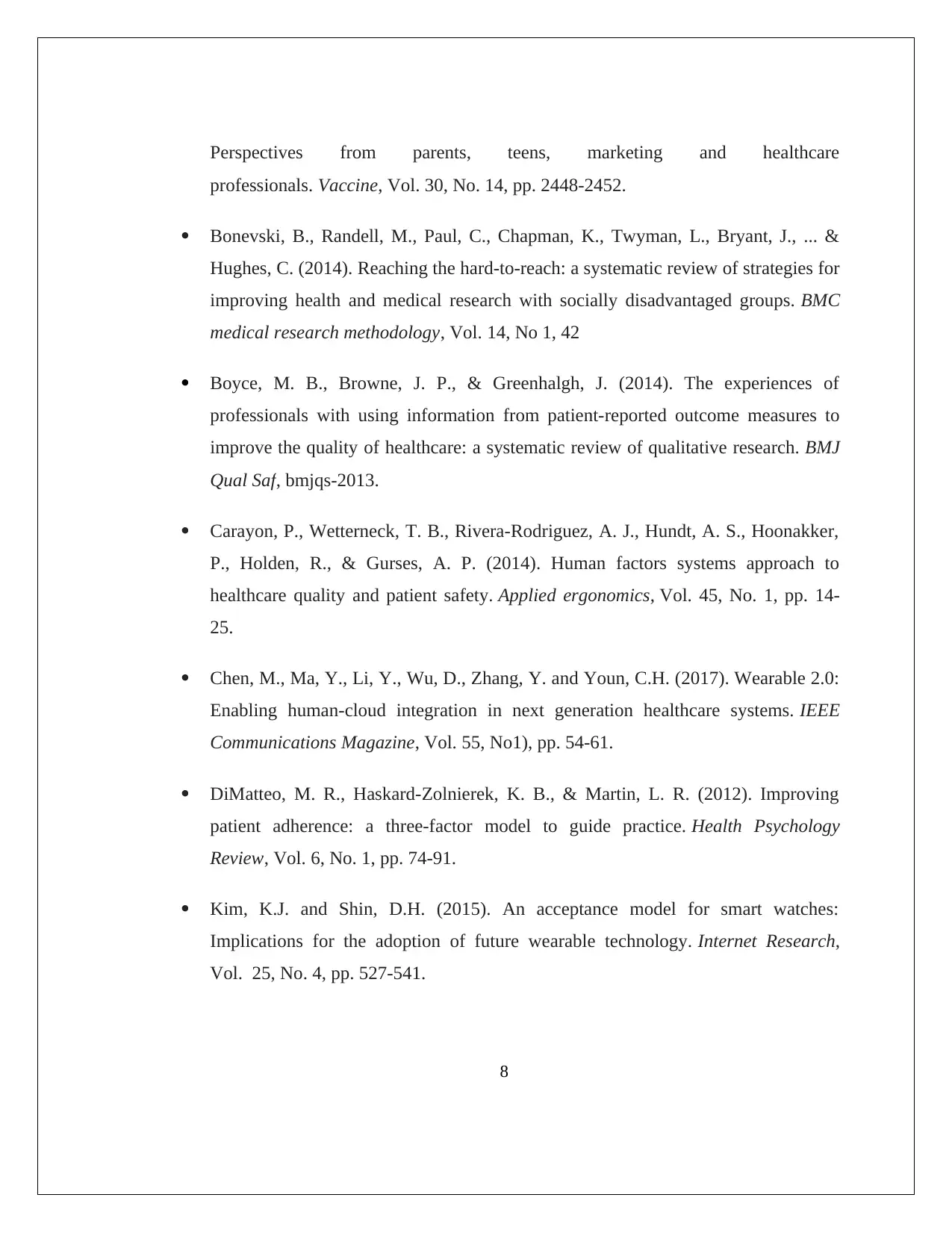
Perspectives from parents, teens, marketing and healthcare
professionals. Vaccine, Vol. 30, No. 14, pp. 2448-2452.
Bonevski, B., Randell, M., Paul, C., Chapman, K., Twyman, L., Bryant, J., ... &
Hughes, C. (2014). Reaching the hard-to-reach: a systematic review of strategies for
improving health and medical research with socially disadvantaged groups. BMC
medical research methodology, Vol. 14, No 1, 42
Boyce, M. B., Browne, J. P., & Greenhalgh, J. (2014). The experiences of
professionals with using information from patient-reported outcome measures to
improve the quality of healthcare: a systematic review of qualitative research. BMJ
Qual Saf, bmjqs-2013.
Carayon, P., Wetterneck, T. B., Rivera-Rodriguez, A. J., Hundt, A. S., Hoonakker,
P., Holden, R., & Gurses, A. P. (2014). Human factors systems approach to
healthcare quality and patient safety. Applied ergonomics, Vol. 45, No. 1, pp. 14-
25.
Chen, M., Ma, Y., Li, Y., Wu, D., Zhang, Y. and Youn, C.H. (2017). Wearable 2.0:
Enabling human-cloud integration in next generation healthcare systems. IEEE
Communications Magazine, Vol. 55, No1), pp. 54-61.
DiMatteo, M. R., Haskard-Zolnierek, K. B., & Martin, L. R. (2012). Improving
patient adherence: a three-factor model to guide practice. Health Psychology
Review, Vol. 6, No. 1, pp. 74-91.
Kim, K.J. and Shin, D.H. (2015). An acceptance model for smart watches:
Implications for the adoption of future wearable technology. Internet Research,
Vol. 25, No. 4, pp. 527-541.
8
professionals. Vaccine, Vol. 30, No. 14, pp. 2448-2452.
Bonevski, B., Randell, M., Paul, C., Chapman, K., Twyman, L., Bryant, J., ... &
Hughes, C. (2014). Reaching the hard-to-reach: a systematic review of strategies for
improving health and medical research with socially disadvantaged groups. BMC
medical research methodology, Vol. 14, No 1, 42
Boyce, M. B., Browne, J. P., & Greenhalgh, J. (2014). The experiences of
professionals with using information from patient-reported outcome measures to
improve the quality of healthcare: a systematic review of qualitative research. BMJ
Qual Saf, bmjqs-2013.
Carayon, P., Wetterneck, T. B., Rivera-Rodriguez, A. J., Hundt, A. S., Hoonakker,
P., Holden, R., & Gurses, A. P. (2014). Human factors systems approach to
healthcare quality and patient safety. Applied ergonomics, Vol. 45, No. 1, pp. 14-
25.
Chen, M., Ma, Y., Li, Y., Wu, D., Zhang, Y. and Youn, C.H. (2017). Wearable 2.0:
Enabling human-cloud integration in next generation healthcare systems. IEEE
Communications Magazine, Vol. 55, No1), pp. 54-61.
DiMatteo, M. R., Haskard-Zolnierek, K. B., & Martin, L. R. (2012). Improving
patient adherence: a three-factor model to guide practice. Health Psychology
Review, Vol. 6, No. 1, pp. 74-91.
Kim, K.J. and Shin, D.H. (2015). An acceptance model for smart watches:
Implications for the adoption of future wearable technology. Internet Research,
Vol. 25, No. 4, pp. 527-541.
8
⊘ This is a preview!⊘
Do you want full access?
Subscribe today to unlock all pages.

Trusted by 1+ million students worldwide
1 out of 22
Related Documents
Your All-in-One AI-Powered Toolkit for Academic Success.
+13062052269
info@desklib.com
Available 24*7 on WhatsApp / Email
![[object Object]](/_next/static/media/star-bottom.7253800d.svg)
Unlock your academic potential
Copyright © 2020–2025 A2Z Services. All Rights Reserved. Developed and managed by ZUCOL.





